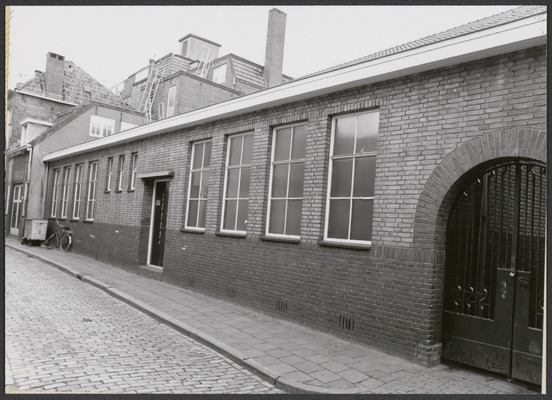Original Dutch text: joodsgroningen.nl
The youth synagogue in Groningen is primarily known as the Jeugdsjoel Groningen (Youth Synagogue Groningen). Jeugdsjoel is an informal term used in some Jewish communities to indicate a synagogue or place of worship specifically intended for youth and young adults. It is a place where young Jewish people gather for religious services, events, and social activities. It is the only remaining youth synagogue in the Netherlands.
The Jewish community in Groningen had grown significantly in the years immediately preceding the war. To keep young people involved in the Jewish community in the future, a youth synagogue was built at number 16 on Folkingedwarsstraat under the inspiring leadership of Rabbi Dasberg. The design for this building was by the architectural firm Kuiler en Drewes, who were also responsible for the construction of the Polak pudding factory, among other projects. The complex includes a prayer room, an administrative office, and four classrooms. The exterior is modest, with a two-tone brick facade. It features eight tall and three smaller windows with narrow cast-iron frames. Above the metal door leading to the courtyard, a round brick arch is built. Two houses are attached to the right side of the building; they were designed in conjunction with the synagogue. The festive opening took place at the end of March 1940.
Just a month and a half later, in May 1940, the Netherlands was occupied, with all its terrible consequences. By 1943, almost all of the city’s Jewish residents had been deported. After the war, few returned. Most had been systematically murdered or perished from the hardships of the camps. Almost nothing remains of the city’s Jewish community. This also affects the large synagogue on Folkingestraat. The building is in poor condition, and the reduced Jewish community cannot afford its maintenance costs. Consequently, the synagogue was sold in 1952. The former youth synagogue was then used as a synagogue. This lasted until 1981. That year, the large synagogue on Folkingestraat was reopened after restoration.
In 1982, it was decided to convert the building into a community center with government subsidies. On October 21, 1983, the “Buurtpand Binnenstad Zuid” (Neighborhood Building Downtown South) opened. The focus was primarily on sports facilities. The main hall, the former prayer room, now houses a gymnasium. Office hours are held once or several times a week in the offices, with a community worker, a social worker, and a social counselor. Residents’ councils also use the building. Later, other activities were also held there. For example, on May 4, 2019, a lecture was held as part of Open Jewish Homes.
In 2018, the municipality of Groningen planned to sell the building. It was ultimately purchased by real estate developer Wijnand van Smeden, who himself played sports in the building for many years. He intends to turn it back into a gym, but the municipality is thwarting these plans. They want to convert it into four apartments with a courtyard, and the plans for this are already in place. Part of the building would have to be demolished for the courtyard. This is despite the fact that it meets 11 of the 12 criteria for national heritage status. It still contains many of the original elements from its time as a youth synagogue.
Youth synagogue squatted
On October 2, 2023, about ten squatters took possession of the building to protest the municipality’s plans and to fight for the preservation of its public function as a social center and its status as a cultural heritage site. According to the squatters, the municipality is acting contrary to its own policy. Instead of protecting and preserving cultural heritage and heritage properties, the municipality is doing the exact opposite. Whether squatting is the right form of protest is up to each individual. The fact is, their intentions are commendable. Let us all please ensure that this piece of Jewish heritage is preserved.
